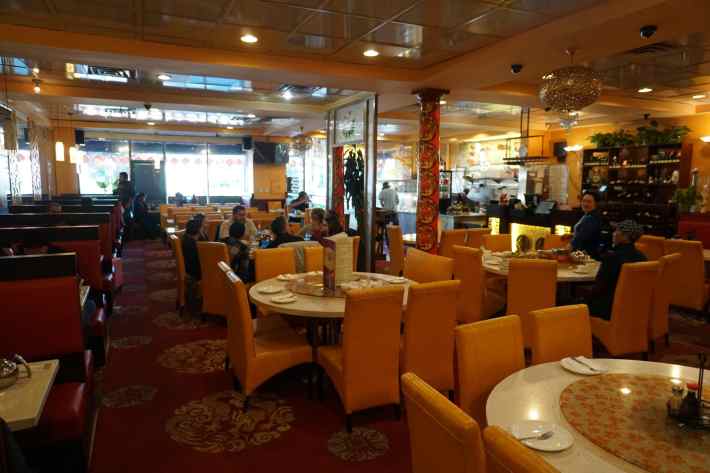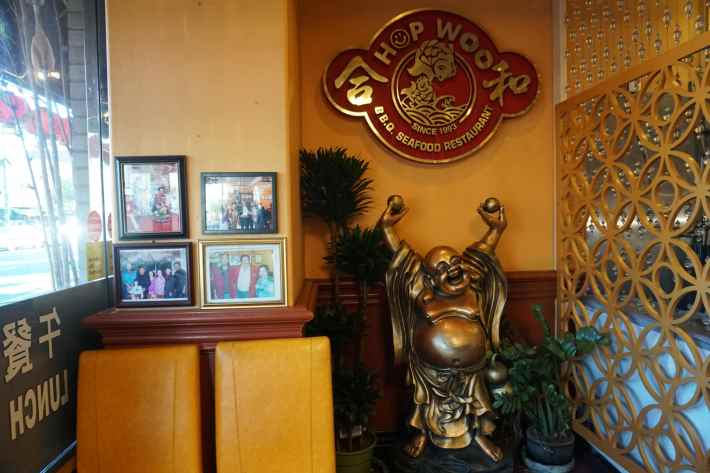y Español better than my English,“ explains Chef Lupe Liang of Hop Woo BBQ & Seafood restaurant. “Because I moved to Mexico in 1978.”
1978 was a historic year for China as well as other nations. Deng Xiaoping, then China’s leader, opened up China to the world. For the first time in its vast history, people could freely leave China’s borders. Thus began Lupe Liang’s journey to Mexico.
Before he was known as Lupe he was Liang Ye Ning. Liang lived in China’s Guangdong province, learning his trade as a cook. He comes from a family of cooks. With a total of ten siblings (7 brothers, 3 sisters), it was inevitable that someone in the family would own a restaurant.
The first in his family to run a restaurant was his third eldest brother, Simon. In 1978, he operated a Chinese restaurant in Mexico’s Rosarito Beach that is still open specializing in Hong Kong and Cantonese cuisine. Liang, then a resident of Hong Kong, moved to Mexico to help him. However, it was Liang’s grandfather who was the very first to relocate to Mexico from China over 100 years ago.

Mexico is also where Liang would meet his future wife, Judy. “My father heard two ladies speaking Cantonese in Mexico at my brother’s restaurant,” explained Liang. “That is not normal.” Liang’s father continued to eavesdrop and eventually introduced himself and asked Judy, who was visiting her cousin if she would like to meet his son. His matchmaking proved successful and they got married.
Like Liang, Judy hails from the Guangdong province but from a small town while her husband is from the big city. Judy, always draped in a glamorous sequined qipao or Chinese gown in the restaurant, runs the front of the house at Hop Woo.
Of all the Chinese restaurants in Chinatown, Hop Woo is the most popular with the Mexican community, so much so that Mexican celebrities adorn his wall of fame including Norteño musician Ramón Ayala.
From observing his dining room over the years, Liang estimates that 50 percent of his customers are Latino—a clientele he’s cultivated. When he’s not busy leading his cooking staff, he works the room like a Chinatown Wolfgang Puck greeting diners with nǐ hǎo, hello, and como estas from table to table.

Lupe’s regulars notice his Spanish agility and word has spread that Hop Woo is the Spanish-friendly Chinese restaurant, and the comida is delicious too.
Menus for Everyone
When we order in a restaurant many of us take for granted the language that’s printed in a menu because usually, it’s English. Chinese restaurants in Chinatown can be even more challenging if you can’t decipher the Chinese characters on the menu. Most of these restaurants have English on the menu along with Chinese, but what if Spanish is your first language and you struggle with English? Even if you can read a bit of English, sometimes the ingredients of Chinese dishes can be hard to interpret; now multiply the effort to understand that item by the encyclopedic listing of dishes in the typical Chinatown restaurant menu and there’s a daunting task just to order lunch.

Fortunately for L.A.’s Spanish-speaking community, Hop Woo also includes Spanish on its menu along with Chinese and English. This may sound like an obvious consideration given the large Hispanic population in the city, but it’s not. Hop Woo is the only Chinese restaurant in Chinatown to do so. When was the last time, other than in a Latin-American or Spanish restaurant, have you seen Spanish on the menu? What Hop Woo did by including Spanish on the menu is basic but also sort of revolutionary.
While living in Tijuana and working in an uncle’s kitchen, Liang picked up some curse words and rudimentary Spanish from his Mexican colleagues. He then decided to step up his language skills and attended adult school. He even changed his name from Liang Ye Ning to Lupe Liang. In the end, his Spanish abilities were equal to his Mandarin and better than his English, although he was most comfortable with Cantonese.
During this past Chinese New Year, Lupe and Judy appeared on Estrella TV Noticias 62 to share with the audience how the Year of the Pig is celebrated.
However, Spanish was not always a notable feature at Hop Woo. “Over 18 years ago, my Español customers asked me if I could put Español on the menu. They tell me they like my food but can’t understand some dishes,” explained Liang. “So we put Español to the menu. We are first one. We are only one.”
El Hop Woo, 26 Years Strong
Opened in 1993, Hop Woo is enjoying its 26th year of business. Lupe and Judy started the bustling restaurant located on Chinatown’s main drag of Broadway and have witnessed shifts in tastes and demographics in the area.

Several years into the operation, Lupe noticed more customers from Mexico, Central, and South America who spoke mainly Spanish. Since he, Judy, and two other Chinese employees spoke Spanish, they’d answer questions and advise on what to order. “Most popular with Spanish speakers is Beef Steak and Asparagus with Black Pepper Sauce on Sizzling Plate,” said Judy. “Lobster, Orange Chicken, and Roast Duck, too,” added Lupe.
“Thanks to Grandfather. He came to Mexico 100 years ago to make a better life.”
Of all the Chinese restaurants in Chinatown, Hop Woo is the most popular with the Mexican community, so much so that Mexican celebrities adorn his wall of fame including Norteño musician Ramón Ayala along with a few Chinese celebrities like film director John Woo.

The Liangs’ reputation for welcoming Spanish-speaking Angelenos has even gotten them their own slice of celebrity culture. During this past Chinese New Year, Lupe and Judy appeared on Estrella TV Noticias 62 to share with the audience how the Year of the Pig is celebrated.
Word must’ve gotten around because at Hop Woo’s Chinese New Year’s celebration this year, families from all over Latin America filled the restaurant, eating traditional Chinese New Year delicacies and even stuffing money into the dancing lion’s flapping mouth. “My customers say this is like a family restaurant for them,” said Judy.
“Thanks to Grandfather. He came to Mexico 100 years ago to make a better life,” said Lupe.
Hop Woo BBQ & Seafood
845 N. Broadway
Los Angeles, CA 90012







